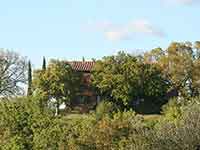The Scrovegni Chapel, dedicated to St. Mary of the Charity, frescoed between 1303 and 1305 by Giotto, upon the commission of Enrico degli Scrovegni, is one of the most important masterpieces of Western art. The frescoes, which narrate events in the lives of the Virgin Mary and Christ, cover the entire walls. On the wall opposite the altar is the grandiose Universal Judgement, which concludes the story of human salvation.
The chapel was originally attached to the Scrovegni family palace, built after 1300, following the elliptical outline of the remains of the Roman arena.
The Chapel was acquired by the City of Padova in1880, and the vulnerable frescoes were subjected to several specialized restoration operations during the 19th and 20th centuries. From the 1970s until today, thanks to close collaboration between the city administration, cultural heritage authorities and the Istituto Centrale per il Restauro, the state of the building, the quality of the air in it, polluting factors, and the state of conservation of the frescoes themselves have all been subjected to careful study and monitoring. The addition of the new access building, with its special air-conditioned waiting-room, means that even great influxes of visitors can enter the Chapel and admire Giotto's masterpiece without further jeopardizing its fragile condition in any way.
In 1300, the wealthy Paduan merchant Enrico Scrovegni bought a piece of land on the site of a former Roman arena. Included in the palace that he built on the site was a chapel dedicated to the Virgin of the Annunciation, Santa Maria Annunziata, and the Virgin of Charity, Santa Maria del Carità.
The family wealth had been amassed by Enrico's father, Reginaldo, whom Dante singled out as the arch usurer in his Inferno. Usury, the lending of money for profit, was considered a sin during the Middle Ages. It is likely that Enrico constructed the chapel as a means to expiate the father's sin. The dedication of the Chapel to the Virgin of Charity, referred to in a document of March of 1304 in which Pope Benedict XI granted indulgences to those who visited "Santa Maria del Carità de Arena," was an obvious choice to disassociate the family from taint of greed and miserliness.
The size and splendor of the Arena Chapel offended the monks of the neighboring Eremitani Church, who lodged a complaint before the Episcopal Curia in Padua. We, thus, can see the Arena Chapel as both a token of Enrico Scrovegni's piety and his contrition for the sins of his father and also as a symbol of his family's status as wealthy merchants who are emulating the aristocracy with the lavish palace and private family chapel. Enrico Scrovegni's seeming conflicting motivations in commissioning the Arena Chapel is brought out in the following passage:
"Among the factors that relate specifically to Enrico Scrovegni are a possible desire to expiate his father's usury and at the same time to make his own expenditure conspicuous; an ambition for status combined with a fear of damnation; a desire, on the one hand, to be regarded as an ascetic devoted to the cult of the Virgin, and, on the other, to secure for himself a fitting property to serve as his personal monument
[
Source: Diana Norman, Siena, Florence, and Padua: Art, Society and Religion 1280-1400, Volume II: Case Studies, p. 92."]
Scrovegni Chapel
Piazza Eremitani, 8
35121 Padua, Italy
The Scrovegni Chapel is open from 9.00 a.m. to 7.00 p.m. all year round
Evening visits: from March 1st, 2011. Evening visits don't take place on non-holiday Mondays.
20 MINUTES VISIT
All evening visits from 19.00 to 22.00
20 - Minute daytime visits are available in January, February, from 16th to 30th June, July, November and from 16th to 31th December.
On-line reservations must be made at least 24 hours in advance.
Information on Ticket Reservation | www.cappelladegliscrovegni.it |
|

The Cappella degli Scrovegni in Padua

Enrico Scrovegni is shown in the fresco of the Last Judgement presenting a model of the chapel to the Virgin: the nobleman offers the three Marys the church that he has donated. He is supported in this by a cleric, whose robe hangs over the real architecture. Giotto is attempting, by means of this illusionistic element and the portrait-like depiction of the donor, a realism which will draw the viewers into the picture.
|


















